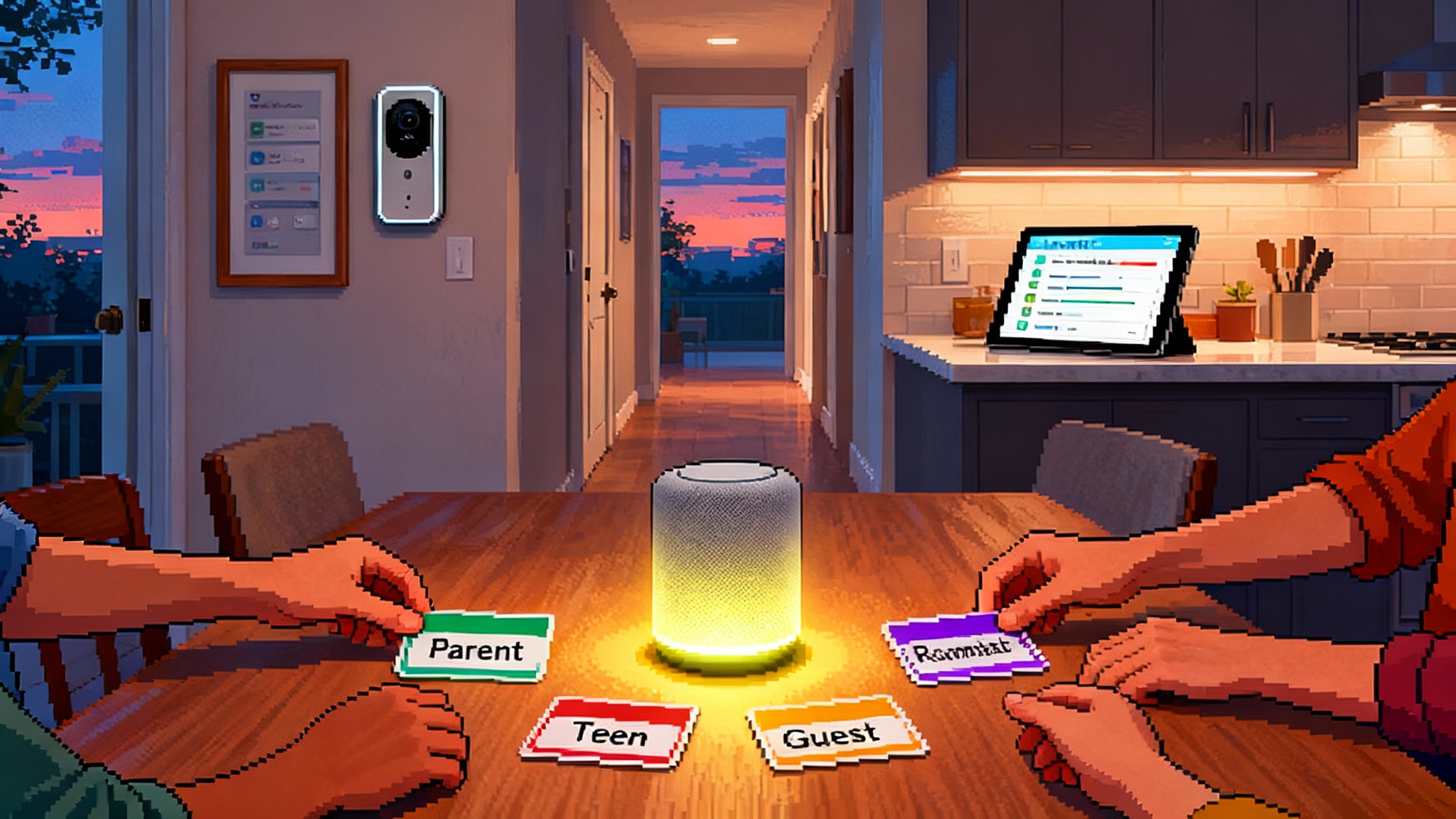Gemini for Home and the Rise of the Communal Assistant
Google’s Gemini for Home reframes the smart home around households, not individuals. Multi user memory, consent, roles, and a simple home constitution will decide how families and roommates actually live with AI every day.

Breaking: the smart home becomes a micro society
On October 1, 2025, Google announced Gemini for Home alongside refreshed Nest hardware and an updated Google Home app. The headline is not faster cameras or a cleaner interface. The shift is conceptual. The assistant now treats the household as the unit of intelligence. Instead of one voice in a cylinder, you get a system that understands a home full of different people, different goals, and constantly shifting contexts.
This is not a cosmetic swap. Early access begins this month across recent Google and Nest devices. A new subscription tier promises conversational summaries of notable activity while you were away as well as richer camera intelligence. More important than features, the launch signals a philosophical change. Living room, kitchen, and entryway are no longer a stack of individual profiles. They are a shared world where preferences collide, memories overlap, and authority must be granted, limited, and sometimes reversed. The smart home has grown into a small society.
From personal helper to household institution
For a decade, voice assistants behaved like pocket calculators with a personality. They set a timer, answered a fact, and flipped a light. That model breaks inside a home because the home is plural.
- The same command can mean different things depending on who speaks it.
- The same event can be remembered differently by different people.
- The same device can be safe for one person to control and risky for another.
Treating the assistant as one owner’s tool forces everyone else into a shadow role. Parents work around it. Roommates roll their eyes. Kids learn to exploit loopholes. A communal assistant reverses the premise. It treats membership, roles, and consent as first class features, not afterthoughts.
The five hard problems of communal intelligence
A communal assistant must solve five problems that the single user model never had to confront.
1) Multi user memory
Personal assistants remember for one person. A communal assistant has to remember for many. That sounds simple until you try to encode it. Who told the system that Grandma arrives at 5 p.m., and who is allowed to see or act on that memory? If two people schedule different pickup times for the same child, which one becomes the household plan? Memory needs scope, provenance, and visibility. Without those, the system becomes confident and wrong.
2) Consent across family members
Homes contain privacy boundaries thicker than corporate firewalls. A child may not want siblings to know when their tutor arrives. A couple may not want houseguests to browse door camera clips. Consent is not a popup. It is the everyday act of letting certain people access certain facts for certain reasons. A communal assistant must learn to ask for consent like a considerate roommate would, at the right time and with just enough context.
3) Role based permissions
Households run on roles: parent, kid, roommate, guest, caregiver, cleaner, contractor. People switch roles during the day. Role based permissions are not just about who can unlock the front door. They determine who can change thermostats, edit routines, approve purchases, silence alerts, or browse camera history. The system needs defaults that feel natural, plus exceptions that are easy and safe. If you want to ground this in established practice, look to the role based access control model used in security engineering, then translate it for everyday life.
4) Arbitration of conflicts
Conflicts will happen. One person says lights off, another says lights on. One person books the kitchen at 6 p.m. for a study session, another wants it for dinner prep. The assistant has to pick a path, explain why, and leave a record. That record is not a legal transcript. It is a practical trust anchor.
5) The home constitution
The only way to make the previous four tractable is to write them down. Not in legalese. In a short, living set of rules that governs how the assistant behaves in your home. Who can invite new devices. Which memories are shared by default. When the system asks for consent. Who gets veto power in an emergency. A home constitution turns tacit norms into explicit instructions.
A blueprint for communal memory
Think about communal memory like a photo album that can also talk. It needs labeled sections, dates, and authors. It must know which pages are private and which are shared. A practical structure looks like this:
- People: verified household members and visitors with voice profiles and device associations.
- Roles: parent, teen, roommate, guest, service provider. Each role has editable default permissions.
- Spaces: rooms and zones, plus virtual spaces like Calendars and Shopping.
- Devices: the physical and digital things under control, with ownership and access scopes.
- Events: things that happened with time, place, and involved people.
- Memories: summaries or facts derived from events and requests, with provenance tags and visibility tags.
Two principles make this work:
- Scope every memory. Each memory should carry a scope label: personal, role, household, or guest. The default might be role for sensitive items and household for routine items like trash day.
- Record who said what. Provenance is a first class field. A memory should say who created it and who edited it.
With these basics, the assistant can answer a question like, “What did we decide about curfew on Friday?” It can parse the collective “we.” It can show the decision text, the people who agreed, and the open objections. It can also distinguish between “we, the parents” and “we, the household.”
Transparent logs people will actually read
Transparency fails when it becomes a dump of machine events. A useful log reads like a concise journal:
- What happened. “Front door unlocked at 3:47 p.m. by Sam’s code.”
- Why it happened. “Temporary access granted for two hours by Mom to dog walker at 2:00 p.m.”
- What the assistant inferred. “Marked package delivery as completed and updated Returns list.”
- What changed. “Kitchen lights scene edited by Alex. Previous version saved.”
Design the log to be skimmed at breakfast. A daily Home Brief can surface exceptions: unusual unlocks, missed routines, changes in shared calendars, and new devices added. Every log item should offer a one tap reversal when possible. If the assistant merged two calendars in error, it should provide an undo that restores both and attaches an explanation.
Good logs create a habit. People stop guessing what the house did and start understanding it. That understanding is the bedrock of trust.
Reversible authority by design
Households delegate. Parents allow a teen to unlock the door after school. Roommates let each other control media in the living room. Delegation must be safe and reversible.
- Time boxed permissions. When you grant access, set a timer by default. The system should nudge you to extend or let it expire.
- One time codes and links. For cleaners or contractors, default to one time access rather than permanent roles.
- Emergency overrides with audit. Allow a designated guardian to break normal rules with an automatic log and a post event review.
- Soft locks. Sometimes the right action is to delay, not deny. If two people issue conflicting commands, the assistant can pause, ask a clarifying question, and summarize the consequences.
Reversibility reduces the fear of getting permissions wrong. It encourages people to share access because the cost of a mistake is low and visible.
Arbitration that feels fair
Choosing who wins in a conflict is less about perfect rules and more about perceived fairness. Build a simple ladder of resolution.
- Clarify intent. “Two requests conflict. Do you want a quiet study scene or a cooking scene in the kitchen at 6 p.m.?”
- Apply local norms. If the home constitution says dinner has priority in shared spaces, apply that and show the rule.
- Offer alternatives. “I can move the study session to the den and dim the lights there.”
- Log the outcome. “Chose Dinner Priority per rule 3.1. Study moved to den. Alex accepted.”
When rules are opaque, arbitration feels like a black box. When rules are explicit and visible, even a loss can feel legitimate.
The home constitution, in plain language
A home constitution does not need to be long. It needs to be clear and easy to revise. Here is a starter template you can adapt.
- Membership. Members are A, B, C. Guests are invited and expire after 24 hours unless renewed.
- Roles and defaults. Parents can unlock doors and edit routines. Teens can unlock doors after 3 p.m. on weekdays. Guests can control media and lights in shared spaces, but not thermostats.
- Consent. Camera clips in private rooms are private by default. Clips in shared spaces are visible to members but not guests. The system asks before sharing clips outside the household.
- Purchases. Any purchase above 50 dollars requires two approvals. The assistant holds orders for one hour for changes or cancellations.
- Conflicts. Shared space scenes follow the shared calendar. Cooking and caregiving scenes have priority over entertainment.
- Exceptions. In an emergency, the guardian can override any rule. The system logs and notifies everyone.
- Data retention. Keep routine logs for 30 days. Keep security logs for 90 days. Allow anyone to export their own interactions at any time.
This little document turns arguments into decisions and decisions into code.
Why this changes product strategy
When Google brings a communal model into the home, the market has to respond. Competitors will ship their own approaches. The lesson for builders is not to race for features, but to adopt a different mental model.
- Design for households, not accounts. Store state at the household level, with clear projections for each person. You are not just syncing preferences. You are negotiating them.
- Make roles a core entity. Role semantics are not an enterprise pattern pasted into the home. They are the everyday texture of family life.
- Treat consent as interaction, not a legal page. Ask at the right moments. Provide previews, not jargon. Offer a default and a clear alternative. For broader context on platform rules as power, see our take on the invisible policy stack.
- Put logs into daily life. Build a Home Brief. Let people search, filter, and replay moments with context. Focus on explanations in everyday language.
- Ship reversibility everywhere. Every powerful action should have an undo with a clear window and a visible trail. This meshes with how assistants as marketplaces must earn trust across multiple participants.
Standards will help. The Matter standard already unifies device control across platforms. The next frontier is shared identity, role semantics, and household policies that travel when you switch ecosystems or add a new device. Builders who embrace portable household policy will win trust when families upgrade or move. If you are new to Matter, start with the Matter standard overview to understand how identity and control are coordinated across vendors.
Field guide: three households, three designs
1) The roommate flat
Three adults share a two bedroom apartment. Rent is split. Schedules diverge. Conflicts cluster around noise and guests.
- Roles. Everyone is an equal member with guest privileges to grant. No one can change door codes without a second approval.
- Scenes. Quiet hours from 10 p.m. to 7 a.m. The assistant nudges with a soft lock on loud scenes and offers headphones or room specific audio.
- Logs. A daily summary flags door events and scene overrides. Each roommate can filter their own interactions.
- Arbitration. Room bookings in the shared calendar decide priority in the living room. If the space is unbooked, the first scene set holds for an hour unless two of three vote to change.
2) The family of five
Two parents, a teen, and two younger children. The priorities are safety, autonomy, and routine.
- Roles. Parents have guardian rights. The teen can unlock doors after school and can control media. Younger children have a tailored profile with bedtime scenes and no commerce. For a broader lens on youth safety design, see our view of the AI teen safety pivot.
- Consent. Camera clips in bedrooms are private. Clips in shared areas are visible to parents and the teen by default with a seven day retention, and anyone can request a clip be blurred or removed from the shared view.
- Purchases. Any purchase over 25 dollars triggers a confirmation to a parent and a hold window. The assistant announces pending orders during dinner.
- Arbitration. Homework and dinner scenes outrank entertainment during weekdays from 5 p.m. to 8 p.m. The assistant offers an entertainment slot after homework is marked done.
3) Multigenerational home with caregiving
An older parent lives with an adult child and their partner. Caregivers visit three times a week.
- Roles. The older parent has privacy rights to their room and calendar. Caregivers receive one time codes and scene access to the rooms they work in.
- Safety. If a fall is detected or if a medication reminder is missed, the assistant alerts the adult child, then a backup contact, then emergency services if needed. Those rules are written in the constitution and visible to all.
- Logs. A discreet health timeline stores event summaries and compliance, visible only to the older parent and the designated caregiver team. Everything is reversible and exportable.
- Arbitration. The older parent’s preferences lead in their room. In shared spaces, the household calendar decides. The system explains every override.
These examples show how the same platform can implement very different social contracts with the same core features.
Implementation notes for builders
If you build products for the home, the jump from me to we demands a few practical patterns.
- Identity. Support multiple verified voice profiles and device presences per household. Treat guest identity as a first class case with expiration by default.
- Memory architecture. Use a memory graph with nodes for people, roles, spaces, devices, and events. Each memory carries scope, provenance, retention, and sensitivity labels. Make forgetting easy and visible.
- Policy engine. Build a human readable policy layer that compiles to rules your devices and services can enforce. Let people edit rules in natural language and show the exact changes, like tracked edits in a document.
- Explanations. Add a What, Why, and How to every significant action. What happened, why the system chose it, and how to reverse or change it.
- Safety rails. Offer simulation. Before a new rule goes live, show how it would have changed the last week. Let people test without fear.
- Developer surface. Provide an API that respects roles and scopes. Third party apps should declare the data they will read and write, the roles they require, and how they handle consent. The assistant should translate household policy into that contract automatically.
What households can do today
You do not need to be an engineer to benefit from the communal model. A few steps can transform your home in a weekend.
- Write your constitution. Keep it on a shared note. Start with membership, roles, consent defaults, and two or three conflict rules. Review it at dinner next week.
- Calibrate access. Give guests one day codes. Give caregivers one time links. Set time boxes on all delegations.
- Turn on the log. Make a daily summary part of breakfast. Treat it like the weather: quick, practical, and shared.
- Practice reversibility. Try the undo on a device change and a purchase. Learn the path before you need it.
- Teach the kids. Explain that the assistant is a shared tool, not a toy. Let them see and edit the rules that affect them.
These are tiny habits with big dividends. They make your home feel more predictable and more respectful.
The near future: first civics, then everything
It is tempting to read Gemini for Home as another upgrade in a product line. The deeper story is social. The home is the first real test of artificial intelligence as a civic actor. It is small enough to manage, human enough to matter, and varied enough to reveal the hard edges. If AI can learn to serve the plural home with memory that honors consent, with logs that illuminate, and with authority that can be granted and reversed, then it will have earned the right to move beyond the countertop speaker.
We are entering an era where the question is not, What can the assistant do, but, How does our household want to live with it. Builders who lean into that question will not just ship features. They will help families, roommates, and caregivers write better rules for shared life. That is the kind of breakthrough that lasts.








